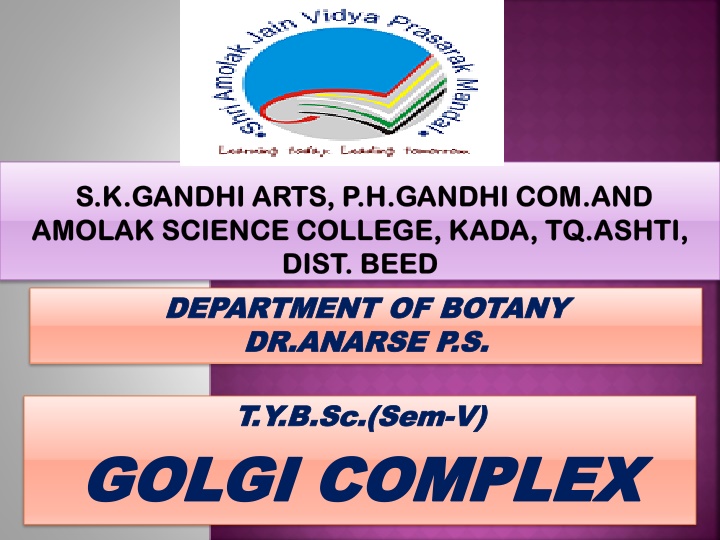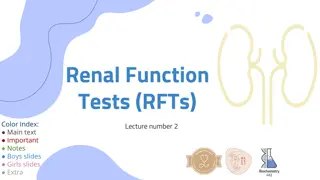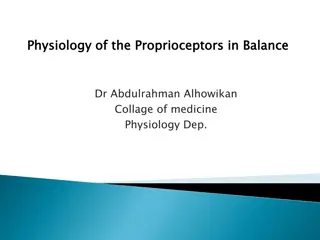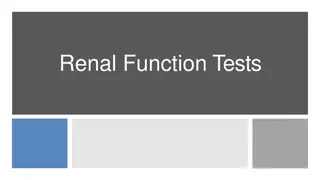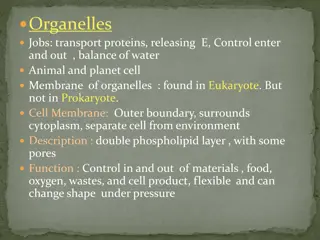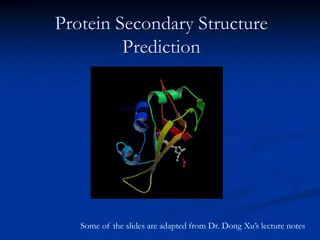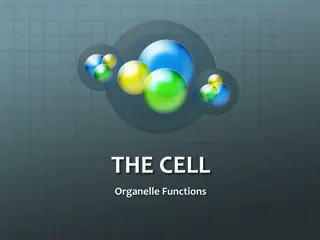Structure and Function of the Golgi Complex
The Golgi complex, an essential cell organelle described by Camillo Golgi in 1898, plays a crucial role in cellular transport and processing. Consisting of flattened sacs called cisternae, large vacuoles, and small tubules, the Golgi complex is involved in modifying, sorting, and packaging proteins and lipids for secretion or delivery to other cellular destinations. This sophisticated organelle varies in size, shape, and position across different cell types, highlighting its dynamic nature in cellular biology.
Download Presentation

Please find below an Image/Link to download the presentation.
The content on the website is provided AS IS for your information and personal use only. It may not be sold, licensed, or shared on other websites without obtaining consent from the author.If you encounter any issues during the download, it is possible that the publisher has removed the file from their server.
You are allowed to download the files provided on this website for personal or commercial use, subject to the condition that they are used lawfully. All files are the property of their respective owners.
The content on the website is provided AS IS for your information and personal use only. It may not be sold, licensed, or shared on other websites without obtaining consent from the author.
E N D
Presentation Transcript
S.K.GANDHI S.K.GANDHI ARTS, AMOLAK AMOLAK SCIENCE COLLEGE, SCIENCE COLLEGE, KADA ARTS, P.H.GANDHI P.H.GANDHI COM.AND KADA, , TQ.ASHTI DIST. DIST. BEED BEED COM.AND TQ.ASHTI, , DEPARTMENT OF BOTANY DEPARTMENT OF BOTANY DR.ANARSE P.S. DR.ANARSE P.S. T.Y.B.Sc T.Y.B.Sc.( .(Sem Sem- -V) V) GOLGI COMPLEX GOLGI COMPLEX
GOLGI COMPLEX Golgi complex is an important cell organelle described by Camillo Golgi in 1898. It is variously designated as Golgi body, Golgi apparatus, lipochondria etc. In plant cell they are called dictyosomes. Occurrence: Animal cell usually has one Golgi complex situated near the nucleus, while in plant cells they are more in numbers scattered throughout cytoplasm. Nerve cells, liver cells & most plant cells also have multiple numbers. Shape and position: The shape of Golgi complex is quite variable in different somatic cell types of animals. Even in the same cell there are variations in different functional stages. The shape is however constant with each cell type.
The position of the Golgi complex is also variable. In cells of ectodermic origin the Golgi complex is polarized between the nucleus & periphery. In secretory cells it lies between the nucleus & secretory pole. Size: The Golgi complex is large in nerve & gland cell, but small in muscle cells. The size is linked to the functional state.
Golgi complex is somewhat curved discoidal organelle which is made up of the three components. Flattened sacs or Cisternae. Large Vacuoles. Small tubules & Vesicles. These membranous structures are characterized by the absence of ribosomes. i.e. they are smooth membrane. Cisternae: The Cisternae are the permanent structure of the Golgi complex. They are membrane bound, fluid filled, flattened sacs swollen as the ends & placed one above the other like stacks of coins.
They are about 3 to 8 in number & are variable in length. The Cisternae are about 150A0 in width& the outer convex surface of each Cisterna is called forming or proximal face. While opposite inner concave surface is called maturing or distal face. The membrane of forming face is similar to ER. While that maturing face is similar to plasma membrane. The membranes of Cisternae are sometimes fenestrated i.e. showing small pores or fenestrae due to complex network of tubules arising from peripheral area.
Vacuoles: The Vacuoles are large membrane bound, fluid filled globular structures. The large vacuoles are clear & generally lie at the edge of the Golgi complex. They represent modified & expanded Cisternae in which the two membranes have become widely separated& the vacuolar spaces enlarge. They contain clear material which reduces metallic salts. Vesicles: The vesicles are smaller membrane bound, fluid filled, and globular structures. They arise from maturing face of Cisternae by budding & thus closely associated with the surface of maturing face of Cisternae. The Cisternae contain specific cellular fluid while Vacuoles & Vesicles often contain enzymes & other products synthesized by cell. The small vesicles are 400-800 A in diameter.
Functions of Golgi complex Secretory Activities:It is mainly concerned with secretion of hormones, enzymes &other materials required building up plasma membrane & cell wall. Storage &synthesis: They stores protein & lipid as well as synthesize complex carbohydrates from simple sugar. Formation of primary lysosomes: The hydrolytic enzymes formed in ER are channelized to cisternae where they are packed up & budded off as primary lysosomes. Formation of acrosome: The apical cap of sperm, called acrosome is also formed with the help of Golgi complex. Packing & forwarding center :Its intimate relationship with E.R. leads to believe that it acts as an intercellular pump for receiving packing & expelling secretory products in the form of small vesicles &transportation of cellular fluid.
Absorption of compounds: Golgi complex absorbs Cu, Au& iron. Plant Cell wall formation :The cell wall of plants is made up of fibrils which contain polysaccharides along with some lipids & proteins. Pigment formation :In many Mammalian tumors& Cancer cells the Golgi complex as site of origin of pigment. Helps in enzyme formation :Golgi complex as a great intracellular centre of enzyme formation.
